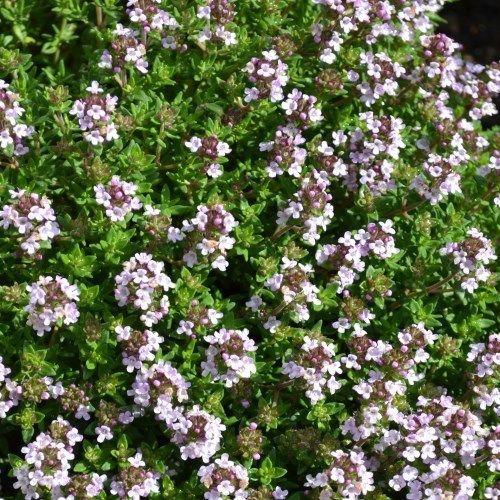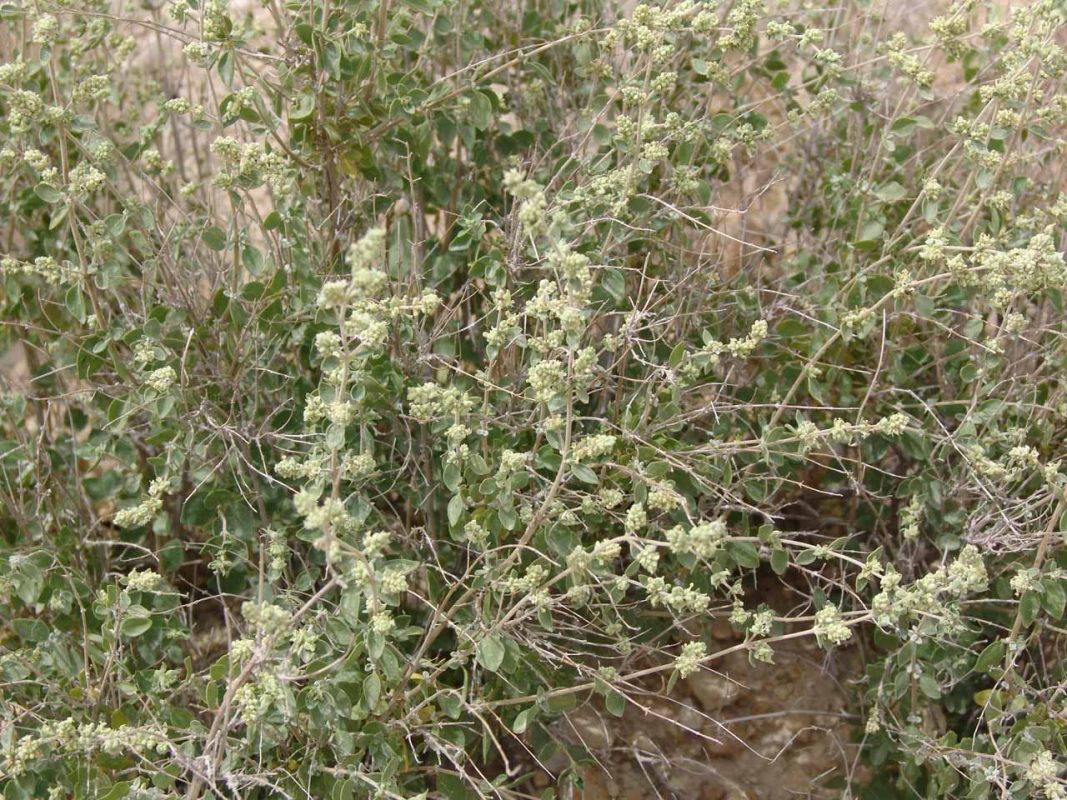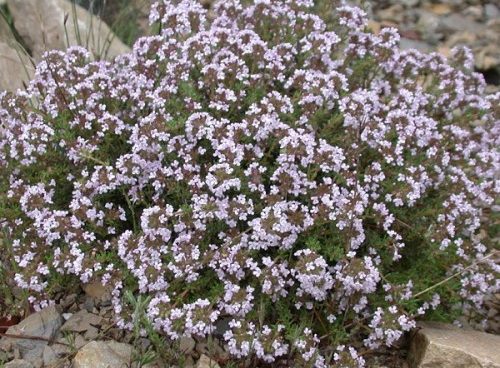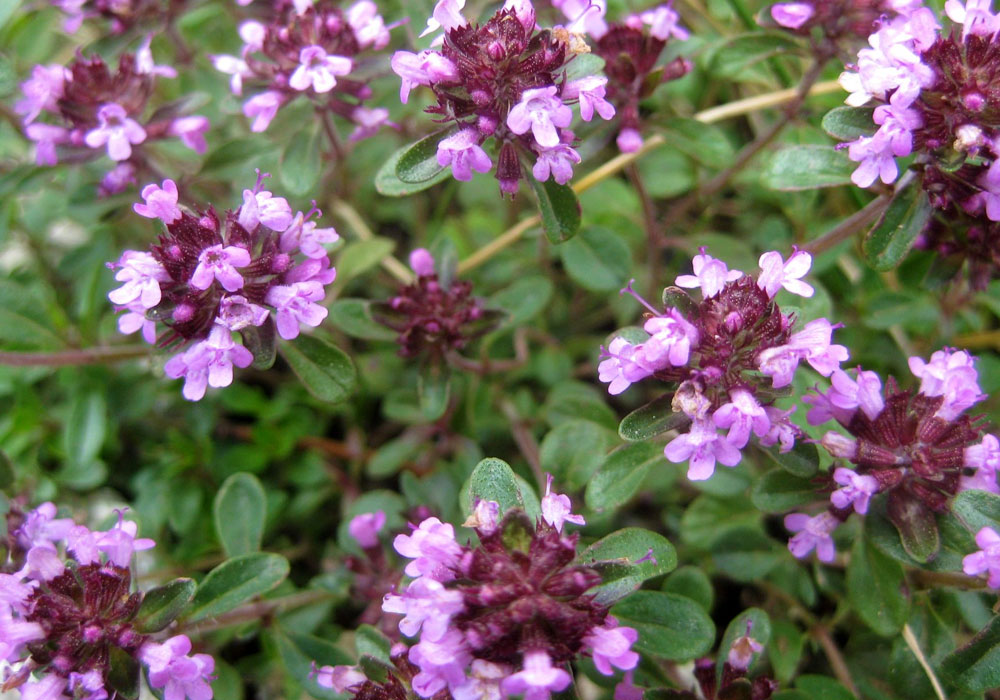Zataria multifloraConstituents of Zataria multiflora The major components of Zataria multiflora essential oil in different regions are summarized in Table 1. Fifty-six compounds were identified in Zataria multiflora essential oil, of which the major constituents are thymol, carvacrol, linalool, and p-cymene. The main components of Zataria multiflora essential oil from the north area of Iran were thymol, carvacrol, p-cymene, and γ-terpinene and α-pinene, representing 80.19% of the total oil. This is consistent with the results of other analyses of Zataria multiflora essential oils, such as EOs obtained from the Shiraz city (collected in May 2010), from Eghlid (Fars province, collected in 2014), or Noor Abad (Fars province, collected in 2010). Thymol was also the main constituent of Zataria multiflora EO collected in mid-May 2009 in the provinces of Isfahan and Bushehr, alongside with c-terpinene, p-cymene, carvacrol, and linalool.Table 1. The major components of Zataria multiflora Boiss essential oil in different regions
| Regions | Major compounds | ||
| Khorasan province | Thymol (42.46%), carvacrol (16.85%), p-cymene (10.62%), γ-terpinene (7.26%), and α-pinene (3.00%) | ||
| Tehran province | Thymol (44.6%), λ-terpinene (21.5%), p-cymene (13.7%), carvacrol (2.35%), and β-caryophyllene (2.20%) | ||
| Fars province | |||
| Shiraz city | Carvacrol (71.12%), λ-terpinene (7.34), and eucaliptol (3.37) | ||
| Shiraz city | Thymol (61.8%), carvacrol (10.5%), p-cymene (7.5%), and γ-terpinene (4.4%) | ||
| Eghlid | Thymol (26.32%), carvacrol (25. 51%), PARA-cymene (8.86%), γ-terpinene (7.93%), and linalool (2.08%) | ||
| Noor Abad | Thymol (30.72%), carvacrol (29.95%), PARA-Cymene (11.38), and γ-terpinene (8.86) | ||
| Farashband | Thymol (46.61%), carvacrol (17.26%), p-cymene (11.51%), γ-terpinene (4.01%), trans-caryophyllene (2.91%), and α-pinene (2.12%). | ||
| Firoozabad | Thymol (37.59%), carvacrol (33.65%); PARA–cymene (7.72%), γ-terpinene (3.88%), and β-caryophyllene (2.06%) | ||
| Isfahan province | |||
| Najafabad | Thymol (64.87%), c-terpinene (9.11%), p-cymene (5.73%), carvacrol (4.65%), and trans-caryophyllene (2.91%). | ||
| Kashan | Carvacrol (61.29%), thymol (25.18%), linalool (1.96%), and p-cymene (1.90%) | ||
| Yazd city | Thymol (40.94%), carvacrol (22.39%), p-cymene (7.73%), and c-terpinene (5.43%). | ||
| Lorestan province (Poldokhtar city) | Thymol (27.05%), p-cymene (9.49%), borneol (7.1%), cis-sabinene hydrate (6.12%), linalool (5.63%), 1,8-cineole (4.28%), c-terpinene (3.96%), terpinene-4-ol (3.72%), spathulenol (2.82%), camphor (2.74%), and carvacrol (2.7%) | ||
| Hormozgan province (Hajiabad) | Thymol (47.46%), p-cymene (13.16%), carvacrol (9.64%), and linalool (7.92%). | ||
Anti-inflammatory effects of Zataria multiflora Anti-inflammatory effects of Zataria multiflora and its constituents are summarized in Table 2. The effect of Zataria multiflora on lung inflammation and cough due to colds was mentioned in traditional medicine . The plant hydroethanolic extract (0.4, 0.8, and 1.6 mg/mL) decreased total WBC, neutrophils, and eosinophils counts in an animal model of chronic obstructive pulmonary disease (COPD). The effects of hydroethanol extract of Zataria multiflora on tracheal responsiveness and emphysema of guinea-pig model of COPD were also reported. In addition, Zataria multiflora showed protective effects on total and differential WBC in the blood and bronchoalveolar lavage fluid as well as on lung pathology, serum levels of PLA2, total protein, and histamine of sensitized guinea-pigs. These results indicate potential therapeutic effects of Zataria multiflora on respiratory systems associated with lung inflammation such as asthma and COPD.Table 2. Anti-inflammatory effects of the extract of Zataria multiflora and its constituents Traditional uses ZM is extensively used as a flavor ingredient in a wide variety of foods. It has a long history of medicinal uses in its native regions. This plant has several traditional uses (via infusion, decoction or vapor) including as a carminative, stimulant, diaphoretic, diuretic, antiseptic, vermifuge, anesthetic, antispasmodic, anthelmintic, antidiarrheal and analgesic (Iranian Herbal Pharmacopoeia, 2002). Additionally, ZM has been commonly used as an antiseptic.One of the ways to resist bacteria is using herbs instead of antibiotics and one of them is the thyme of Shiraz.The dry leaves of it are used in the food products as retentive and flavour which constrains the innate security and prevents from the progress of some microorganisms like bacteria and fungus.Using natural flavours as antibacterial combinations is a good solution to control pathogenic bacteria and increasing the time of processed foods durability and causes the hygienic dangers and economic damages to increase which are due the progress of Microorganism cause of the nutritional sources.This herb is used as the flavour in lots of Iranian foods and is antioxidant, antibacterial and disinfectant. This herb is made from the tree and is one of the branches of mints and is traditionally used as the flavour in foods. Thymol is one of the important combinations of the oxide monoterpene and is antibacterial and antifungal and avoids mycotoxins production which is found in the essence of thyme and lots of other herbs..Antioxidant effects of Zataria multifloraZataria multiflora has high amounts of phenolic monoterpenes as carvacrol and thymol which showed potent antioxidant activities. Antioxidant and free radicals scavenging activities of Zataria multiflora and its constituents have been reported in several studies which show that this plant can be considered as a potential source of natural antioxidant for traditional and medicinal uses.
Extract and constituents
Doses
Model of study
Effects
Aqueous-ethanolic
0.4, 0.8, and 1.6 mg/mL, p.o.
Guinea-pig model of COPD
Improvement of IL-8 level, total WBC number, and lymphocytes percentage
0.4, 0.8, and 1.6 mg/mL
Guinea-pig model of COPD
Improvement of tracheal responsiveness and emphysema
0.2, 0.4, and 0.8 mg/mL, p.o.
Guinea-pig model of asthma
Reduction in TR to methacholine and OA, serum levels of NO, nitrite, and PLA2
0.2, 0.8, and 1.4 g/kg, i.p.
Albino mice model of paw inflammation
Inhibitory activities against acute inflammation
0.2, 0.8, and 1.4 g/kg, i.p.
Rat model of paw inflammation
Inhibitory activities against chronic inflammation
Aqueous-methanolic
400, 600, and 900 ppm in drinking water
Albino mice model of bowel inflammation
Reduction the score of macroscopic and microscopic characters acetic acid-treated group
Aqueous-ethanolic
500 and 900 and essential oil 0.3 mL/kg, i.p.
Wistar rats model of paw inflammation
Anti-inflammatory effects
Carvacrol
40, 80, and 160 μg/mL
Guinea-pig model of asthma
Improvement of TR, serum level of NO and nitrite, and total and differential WBC
40, 80, and 160 μg/mL
Guinea-pig model of asthma
Anti-inflammatory effects similar to dexamethasone.
50 and 100 mg/kg, i.p.
Swiss mice model of paw inflammation
Reduction in IL-1β and prostanoids
60, 120, and 240 μg/mL
Guinea-pig model of COPD
Improvement of TR and emphysema
0.3, 1, 3, 10, 30, or 90 μg/mL, o.p.
Wistar rats model of ear edema
Inhibition of leukocyte migration and reduction in edema formation
50 or 100 mg/kg; i.p.
Swiss mice model of pleurisy and paw edema
Inhibition of the edema, TNF-α, and the recruitment of leukocytes
1, 10, and 100 μg/mL
Murine peritoneal macrophages (in vitro)
Reduction in the nitrite production
100, 200, or 400 μm
U937 cells
Suppression of LPS-induced COX-2
100 μg/cm2
Mice model of ear edema
Reduction in topical edema
50 mg/kg, o.p
Fischer 344 Rats model of colitis
Suppression of the pro-inflammatory mediators such as iNOS and IL-1β
Thymol
10, 20 μg/mL
HNC stimulated by FMLP
Inhibition of elastase releasing
0.2 microm
In vitro
Inhibition of COX-1
50 μg/mL and 200 μg/mL
In vitro (PHA)-SPBL
Inhibition of lymphocyte proliferation
1.5, 15, and 150 μg/mL
Leukocytes cells stimulated by FMLP
Chemoattractant potent
400 mg/kg
Wistar rats model of ear edema
Reduction in the inflammatory exudates
10, 30, and 100 mg/kg, i.p.
Rats wound model
Reduction in edema, leukocyte influx, inhibition of MPO, and improvement of granulation reaction
Linalool
50 or 200 mg/kg, i.p.
Mice model of paw edema
Reduction in CFA-induced hypersensitivity and paw edema in mice
(25 mg/kg, a.s.)
Rats model of edema
Inhibition of edema
40, 80, and 120 μg/mL
RAW 264.7 cells
Inhibition of IL-6, TNF-α, phosphorylation of IκBα, p38, c-Jun terminal kinase, and extracellular signal-regulated kinase
25 mg/kg, i.p.
Mice model of acute lung injury
Reduction in TNF-α, IL-6, lung histopathological changes, total WBC, neutrophils, and macrophages in BALF
γ-terpinene
25 mg/kg or 50 mg/kg, p.o.
Swiss mice model of paw edema
Reduction in PGE2 and histamine-induced paw edema
25 mg/kg, p.o.
Swiss mice model of peritonitis model
Reduction in IL-1β and TNF-α production
25 mg/kg, p.o.
Swiss mice model of lung inflammation
Reduction in neutrophil migration as well as PMN cells migration to the BAL
0.03–6 mg/paw
Rats model of paw edema
Inhibition of edema formation only in 6 mg/paw
p-cymene
1250 ppm
Mice model of colitis
Reduction in IL-6 but not suppressing of IL-1β
0.2% and 0.1%
Mice model of colitis
Reduction in IL-1β and IL-6 cytokines
5000 ppm
Mice model of colitis
Inhibition of total mRNA IL-1β expression but do not affect IL-6 expression
50, 100, or 200 mg/kg; p.o.
Rats model of paw edema
Inhibitory activity on edema formation
50, 100, or 200 mg/kg; p.o.
Mice model of abdominal writhes
Inhibitory effect on abdominal writhes and leukocyte migration into the peritoneal cavity




